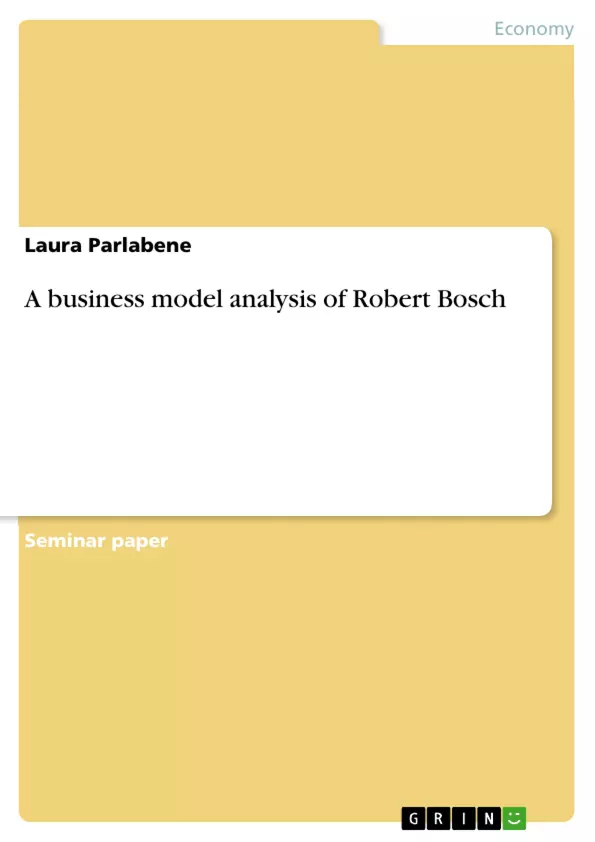„Invented for life“– that is the slogan of Robert Bosch (RB). By following this guiding principle the last 125 years, RB has become a leading multinational supplier of technology and services.
The main objective of the present paper is to analyze the business model of RB and the aspects relevant for its success by focusing on three business model components.
The first component, which is analyzed in chapter 2, is the strategic component. It includes the strategy, the core competencies, and the networks of RB. The second component, presented in chapter 3, is the market component, which is focused on the product supply, the customers, and the revenue streams. The third component, shown in chapter 4, is the value-added component. Within this component, the key activities and key resources of RB will be examined further.
Inhaltsverzeichnis (Table of Contents)
- 1 Introduction
- 2 Strategic component of the business model
- 2.1 Strategy and core competencies
- 2.2 Networks
- 3 Market component of the business model
- 3.1 Product supply
- 3.2 Customers and revenue streams
- 4 Value-added component of the business model
- 4.1 Key activities
- 4.2 Key resources
- 5 Conclusion
Zielsetzung und Themenschwerpunkte (Objectives and Key Themes)
This scientific paper provides a comprehensive analysis of the business model of Robert Bosch (RB), a global leader in automotive technology and industrial equipment. The paper aims to examine the strategic, market, and value-added components of RB's business model and to understand how these components contribute to the company's success.
- Strategic components of RB's business model, including its core competencies and networks
- Market component of RB's business model, focusing on product supply and customer relations
- Value-added component of RB's business model, encompassing key activities and resources
- Analysis of RB's business model in the context of its strategic goals and competitive environment
- Insights into the factors that contribute to RB's success and its long-term sustainability
Zusammenfassung der Kapitel (Chapter Summaries)
- Chapter 1: Introduction - This chapter provides an overview of the business model concept and its relevance for understanding the strategic direction of companies like Robert Bosch. It also outlines the scope and objectives of the paper.
- Chapter 2: Strategic component of the business model - This chapter explores the strategic elements of RB's business model, including its core competencies and network strategies. It examines how these elements contribute to the company's competitive advantage.
- Chapter 3: Market component of the business model - This chapter focuses on the market-related aspects of RB's business model, analyzing its product supply chain and customer relationships. It explores the factors that influence customer satisfaction and revenue generation.
- Chapter 4: Value-added component of the business model - This chapter delves into the value-added components of RB's business model, examining its key activities and resources. It analyzes how these elements contribute to the overall value proposition of the company.
Schlüsselwörter (Keywords)
The key words and focus topics of this scientific paper include business model analysis, Robert Bosch, strategic management, core competencies, networks, product supply, customer relations, value-added components, key activities, key resources, competitive advantage, and long-term sustainability.
- Citar trabajo
- Laura Parlabene (Autor), 2012, A business model analysis of Robert Bosch, Múnich, GRIN Verlag, https://www.grin.com/document/204371



